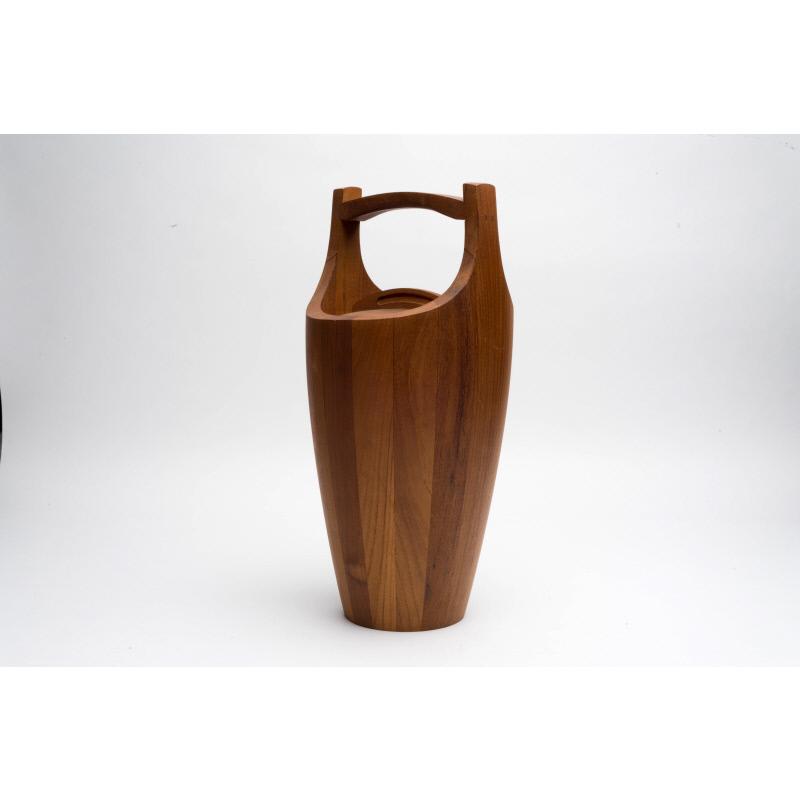Ice bucket
Classification(s):
Wood
Date: c.1951 - 1976
Organisation: Dansk (Danish)
Designer: Jens Harald Quistgaard (Danish, 1919 - 2008)
Dimensions:
480 × 230 mm (48 × 23 cm)
Medium: Teak
Object number: W17D
See Also
Place of Production:Denmark
DescriptionTeak 'Congo' ice bucket, designed by Jens H. Quistgaad in 1955 for Dansk, Denmark. The interior is lined with orange plastic.
Incised to the base “811 Dansk Design”.
Incised to the base “811 Dansk Design”.
ProvenanceThis object was originally acquired for the Inner London Education Authority’s (ILEA) ‘Circulating Design Scheme’ collection.
The collection was instigated by the London Country Council (later the Greater London Council) and the Council of Industrial Design (COID). The collection’s original purpose was concerned with the teaching and dissemination of modern, ‘good design’.
The collection was established in 1951/52 as the ‘Experiment in Design Appreciation’, later renamed the ‘Circulating Design Scheme’.
The Circulating Design Scheme lent boxed showcases to London schools. The showcases contained handling objects, material samples and interpretation on a specific subject.
COID withdrew its involvement in the Scheme in 1957. After which time, it was managed exclusively by the London County Council from 1957-1963.
After the administrative restructuring of London authorities, the Scheme was jointly managed by the Greater London Council and the Inner London Education Authority (ILEA) from 1963 – 1976.
The Scheme was operational until 1976 when the collections were withdrawn from circulation. ILEA was abolished in the late 1980s and the collection was donated to Camberwell College of Arts in 1989/90.
ILEA was responsible for secondary and tertiary education in the inner London boroughs, this included Camberwell.
The collection was instigated by the London Country Council (later the Greater London Council) and the Council of Industrial Design (COID). The collection’s original purpose was concerned with the teaching and dissemination of modern, ‘good design’.
The collection was established in 1951/52 as the ‘Experiment in Design Appreciation’, later renamed the ‘Circulating Design Scheme’.
The Circulating Design Scheme lent boxed showcases to London schools. The showcases contained handling objects, material samples and interpretation on a specific subject.
COID withdrew its involvement in the Scheme in 1957. After which time, it was managed exclusively by the London County Council from 1957-1963.
After the administrative restructuring of London authorities, the Scheme was jointly managed by the Greater London Council and the Inner London Education Authority (ILEA) from 1963 – 1976.
The Scheme was operational until 1976 when the collections were withdrawn from circulation. ILEA was abolished in the late 1980s and the collection was donated to Camberwell College of Arts in 1989/90.
ILEA was responsible for secondary and tertiary education in the inner London boroughs, this included Camberwell.
NotesThis object was circulated to London schools as part of the Inner London Education Authority’s (I.L.E.A) Circulating Design Scheme, which operated from 1951-1976. The teak ice-bucket featured in the ‘Timber Worked by Machine’ group in an unnumbered case. The boxed showcase displays wooden objects that have been “cut, shaped, smoothed and assembled by machine”. The original supplier from whom this object was acquired is unknown. The photograph does not have an associated record card. Original photograph of boxed showcase © London Metropolitan Archives: City of London.
Jens Harald Quistgaard was trained in sculpture by his father, at the age of 15 he took up blacksmithing and later he became an apprentice in the studio of silversmith George HJensen. In 1954, Quistgaard’s designs for a teak and stainless steel knife and fork were displayed in a Copenhagen museum. This led to a working relationship with entrepreneur Ted Nierenberg who, together with Quistgaard, founded Dansk International Designs – manufacturing flatware with the belief that tableware could be useful and beautiful. Dansk's first logo was designed and hand-drawn by Quistgaard in 1954. He designed Dansk's first products – and hundreds more over the years. Quistgaard was known for his elegant but functional designs, created by combining materials such as exotic woods and stainless steel.
Jens Harald Quistgaard was trained in sculpture by his father, at the age of 15 he took up blacksmithing and later he became an apprentice in the studio of silversmith George HJensen. In 1954, Quistgaard’s designs for a teak and stainless steel knife and fork were displayed in a Copenhagen museum. This led to a working relationship with entrepreneur Ted Nierenberg who, together with Quistgaard, founded Dansk International Designs – manufacturing flatware with the belief that tableware could be useful and beautiful. Dansk's first logo was designed and hand-drawn by Quistgaard in 1954. He designed Dansk's first products – and hundreds more over the years. Quistgaard was known for his elegant but functional designs, created by combining materials such as exotic woods and stainless steel.







